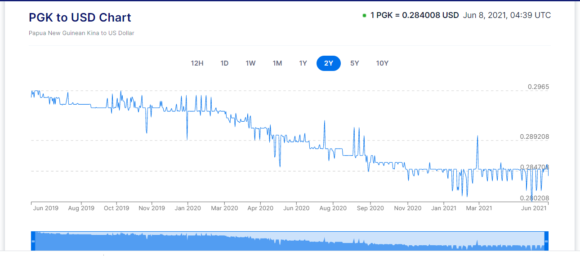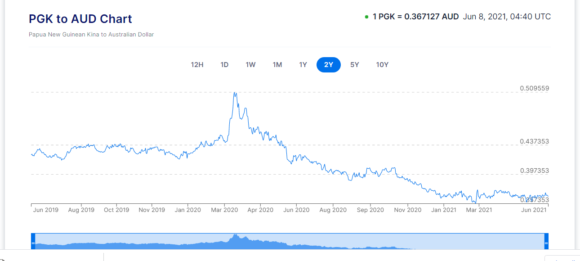Papua New Guinea’s currency, the kina, has been steady this year after weakening against a number of major currencies in late 2020. Should it be devalued further? We asked Jonathan Prince, Treasurer at Westpac PNG, to consider the consequences.
Last year, there were calls from business for PNG’s currency to be devalued, in part to help address the country’s ongoing foreign exchange shortages.
Notably, the kina has been held steady against the US dollar over the past six months. The Bank of Papua New Guinea’s reference rate has not changed since November 2020, when it was held at K0.285 to the US dollar.
Against other currencies, however, there has been some movement.
Since early November, the kina has fallen by seven per cent against the Australian dollar, although recently the rate has been steady at about K0.37.
A similar pattern has been seen with the euro. Since November 2020, the kina has fallen against the euro by about four per cent, but this year it has remained steady at about 0.24. The kina has remained largely unchanged against the yen and the New Zealand dollar in 2021.
Westpac PNG’s Treasurer Jonathan Prince says these movements are the result of movements between the US dollar and other major currencies rather than anything to do with the kina.
‘Any movement of the major currencies against the US dollar is reflected in a lower kina cross rate,’ he tells Business Advantage PNG.
Prince points out that, since most of the inward flow of currency into PNG is denominated in US dollars, ‘the adjustment process is mostly felt by import customers who have to buy in Australian dollars.’
Devaluation?
Prince says the contraction of the economy because of COVID-19 is the single factor having the biggest effect on capital and trade flows, rather than the exchange rate.
‘Growth is forecast this year but I am not sure we are really seeing that. So, imports are lower. I don’t think that is necessarily driven by the exchange rate or imports being more expensive. It is just that the economy has contracted and is only recovering slowly.
Nevertheless, the PNG authorities, according to Prince, have two choices: to maintain tight exchange rate controls or to ‘let the exchange rate go’, which would reduce the level of imports as they would become more expensive. He says the Bank of PNG has chosen the former route.
‘The economic theory is that, if the kina is allowed to devalue, it should clear the foreign exchange imbalance. The IMF is on record saying the Bank of PNG should promote a more rapid adjustment in the exchange rate to address forex shortages and the backlog of orders. They draw a direct link to a lower exchange rate and encouraging investment to come in.
‘My personal view is that it would be helpful if the kina was allowed to adjust at a slightly faster rate.’
‘The Central Bank’s position is that a lower exchange rate won’t necessarily encourage inward investment. If you are running a mine in PNG, costs are largely fixed. It is not going to encourage more investment where an asset has fixed costs. I do have some sympathy with that argument. If the exchange rate drops, in the short term I don’t think PNG will necessarily export more, or bring more foreign investment
‘But, at the margin, it may make oil and gas or mining projects, more profitable. It may also encourage investment in agricultural production, a sector that is vital to millions of rural Papua New Guineans. My personal view is that it would be helpful if the kina was allowed to adjust at a slightly faster rate.
‘Before November, we saw a gradual depreciation of the kina, something like 5 to 10 [basis] points a month. I think that would be helpful in terms of helping the kina to adjust and does get closer to a rate that will help manage the foreign exchange imbalance.’
Prince acknowledges there is also a risk is that a lower exchange rate will push up food and other costs for Papua New Guineans. But he notes that inflation is already present in PNG: the central bank is predicting an inflation rate of 4.5 per cent for 2021.











Speak Your Mind